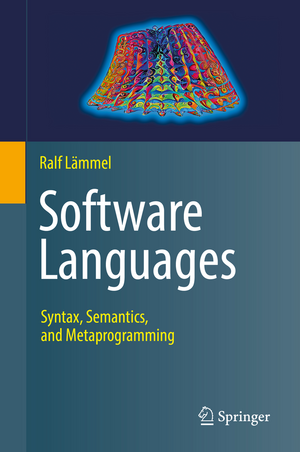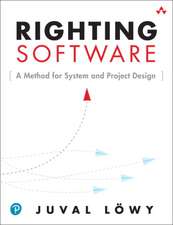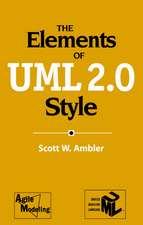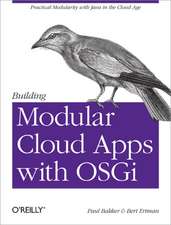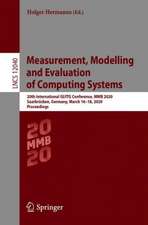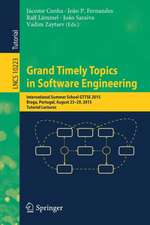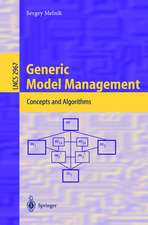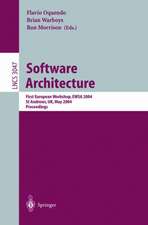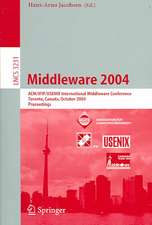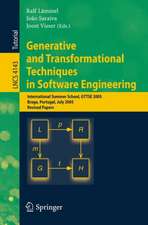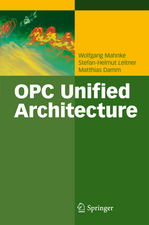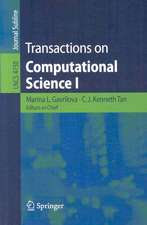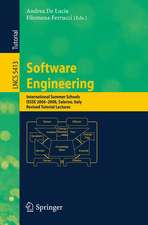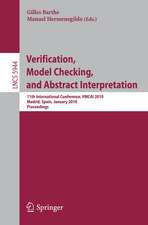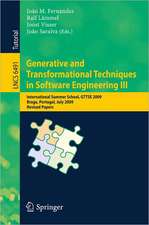Software Languages: Syntax, Semantics, and Metaprogramming
Autor Ralf Lämmelen Limba Engleză Hardback – 28 mai 2018
This book identifies, defines and illustrates the fundamental concepts and engineering techniques relevant to applications of software languages in software development. It presents software languages primarily from a software engineering perspective, i.e., it addresses how to parse, analyze, transform, generate, format, and otherwise process software artifacts in different software languages, as they appear in software development. To this end, it covers a wide range of software languages – most notably programming languages, domain-specific languages, modeling languages, exchange formats, and specifically also language definition languages. Further, different languages are leveraged to illustrate software language engineering concepts and techniques. The functional programming language Haskell dominates the book, while the mainstream programming languages Python and Java are additionally used for illustration.
By doing this, the book collects and organizes scattered knowledge from software language engineering, focusing on application areas such as software analysis (software reverse engineering), software transformation (software re-engineering), software composition (modularity), and domain-specific languages. It is designed as a textbook for independent study as well as for bachelor’s (advanced level) or master’s university courses in Computer Science. An additional website provides complementary material, for example, lecture slides and videos.
This book is a valuable resource for anyone wanting to understand the fundamental concepts and important engineering principles underlying software languages, allowing them to acquire much of the operational intelligence needed for dealing with software languages in software development practice. This is an important skill set for software engineers, as languages are increasingly permeating software development.
| Toate formatele și edițiile | Preț | Express |
|---|---|---|
| Paperback (1) | 340.32 lei 6-8 săpt. | |
| Springer International Publishing – 22 dec 2018 | 340.32 lei 6-8 săpt. | |
| Hardback (1) | 733.36 lei 6-8 săpt. | |
| Springer International Publishing – 28 mai 2018 | 733.36 lei 6-8 săpt. |
Preț: 733.36 lei
Preț vechi: 916.70 lei
-20% Nou
Puncte Express: 1100
Preț estimativ în valută:
140.34€ • 146.34$ • 116.64£
140.34€ • 146.34$ • 116.64£
Carte tipărită la comandă
Livrare economică 20 martie-03 aprilie
Preluare comenzi: 021 569.72.76
Specificații
ISBN-13: 9783319907987
ISBN-10: 3319907980
Pagini: 424
Ilustrații: XXX, 424 p. 49 illus., 32 illus. in color.
Dimensiuni: 155 x 235 x 33 mm
Greutate: 6.75 kg
Ediția:1st ed. 2018
Editura: Springer International Publishing
Colecția Springer
Locul publicării:Cham, Switzerland
ISBN-10: 3319907980
Pagini: 424
Ilustrații: XXX, 424 p. 49 illus., 32 illus. in color.
Dimensiuni: 155 x 235 x 33 mm
Greutate: 6.75 kg
Ediția:1st ed. 2018
Editura: Springer International Publishing
Colecția Springer
Locul publicării:Cham, Switzerland
Cuprins
1 The Notion of a Software Language.- 2 A Story of a Domain-Specific Language.- 3 Foundations of Tree- and Graph-Based Abstract Syntax.- 4 Representation of Object Programs in Metaprograms.- 5 A Suite of Metaprogramming Scenarios.- 6 Foundations of Textual Concrete Syntax.- 7 Implementation of Textual Concrete Syntax.- 8 A Primer on Operational Semantics.- 9 A Primer on Type Systems.- 10 An Excursion into the Lambda Calculus.- 11 An Ode to Compositionality.- 12 A Suite of Metaprogramming Techniques.
Recenzii
Selected by Choice magazine as an Outstanding Academic Title for 2019
“The book’s 12 chapters cover a wealth of information by adopting a formal point of view that supplies the rigor needed for such an extensive treatment while offering plenty of self-learning opportunities through exercises and additional references. … This book is also useful as the first step in a more in-depth exploration of specific topics, such as metaprogramming, as it provides the references needed for a comprehensive literature review. … Summing Up: Highly recommended. Advanced undergraduates through faculty and professionals.” (L. Benedicenti, Choice, Vol. 56 (9), May, 2019)
Notă biografică
Ralf Lämmel is Software Engineer at Facebook since 2018 and Professor of Computer Science (currently on leave of absence) at the University of Koblenz-Landau in Germany since 2007. In the past, he had held positions at the University of l'Aquila, Microsoft, the Free University of Amsterdam, CWI (Dutch Center for Mathematics and Computer Science), and the University of Rostock, Germany. His research and teaching interests include software language engineering, software reverse engineering, software re-engineering, mining software repositories, functional programming, grammar-based and model-based techniques, and, more recently, megamodeling. He is one of the founding fathers of the international summer school series on Generative and Transformational Techniques on Software Engineering (GTTSE) and the international conference on Software Language Engineering (SLE).
Textul de pe ultima copertă
This book identifies, defines and illustrates the fundamental concepts and engineering techniques relevant to applications of software languages in software development. It presents software languages primarily from a software engineering perspective, i.e., it addresses how to parse, analyze, transform, generate, format, and otherwise process software artifacts in different software languages, as they appear in software development. To this end, it covers a wide range of software languages – most notably programming languages, domain-specific languages, modeling languages, exchange formats, and specifically also language definition languages. Further, different languages are leveraged to illustrate software language engineering concepts and techniques. The functional programming language Haskell dominates the book, while the mainstream programming languages Python and Java are additionally used for illustration.
By doing this, the book collects and organizes scattered knowledge from software language engineering, focusing on application areas such as software analysis (software reverse engineering), software transformation (software re-engineering), software composition (modularity), and domain-specific languages. It is designed as a textbook for independent study as well as for bachelor’s (advanced level) or master’s university courses in Computer Science. An additional website provides complementary material, for example, lecture slides and videos.
This book is a valuable resource for anyone wanting to understand the fundamental concepts and important engineering principles underlying software languages, allowing them to acquire much of the operational intelligence needed for dealing with software languages in software development practice. This is an important skill set for software engineers, as languages are increasingly permeating software development.
Caracteristici
The first textbook on software language engineering, with a strong focus on application areas such as domain-specific languages, software composition, and software reverse engineering Covers a wide range of languages, from functional languages like Haskell to mainstream programming languages like Java and modeling languages like UML Complemented by a website providing additional teaching material such as lecture slides, software artifacts, and videos
